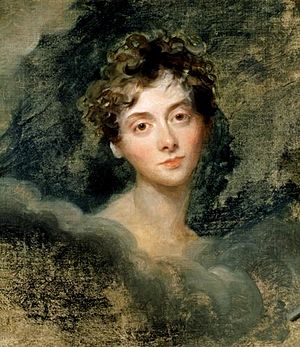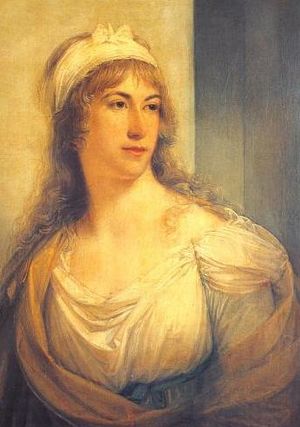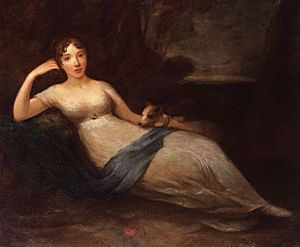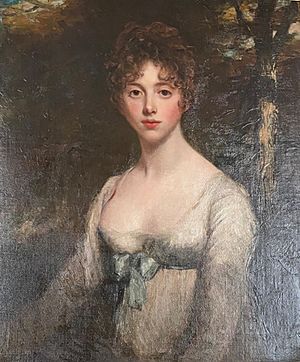Lady Caroline Lamb facts for kids
Quick facts for kids
Lady Caroline Lamb
|
|
|---|---|

Lady Caroline Lamb, painted by Sir Thomas Lawrence
|
|
| Born | 13 November 1785 |
| Died | 25 January 1828 (aged 42) |
| Spouse(s) | |
| Children | Stillbirth child George Augustus Frederick A daughter |
| Parent(s) |
|
Lady Caroline Lamb (born Ponsonby; November 13, 1785 – January 25, 1828) was an Anglo-Irish noblewoman and writer. She is best known for her Gothic novel Glenarvon. In 1812, she had a famous connection with Lord Byron. She famously described him as "mad, bad, and dangerous to know". Her husband was William Lamb, who later became a British prime minister.
Contents
Lady Caroline Lamb: A Life in the Spotlight
Her Early Life and Family
Caroline was the only daughter of Frederick Ponsonby, 3rd Earl of Bessborough. He was an Anglo-Irish nobleman. Her mother was Henrietta, Countess of Bessborough. Before her father became an Earl in 1793, she was known as the Honourable Caroline Ponsonby.
Caroline was related to many important women in society. Her aunt was Georgiana Cavendish, Duchess of Devonshire. She was also a cousin by marriage to Annabella, Lady Byron. She was even related to Diana, Princess of Wales. Caroline was never Viscountess Melbourne herself. This is because she passed away before her husband inherited the title.
Growing Up and Learning

As a young child, Caroline was often sick. She spent a lot of time in the countryside for her health. She also traveled to Italy with her mother and family. There, she recovered from a serious illness.
After returning to England, she lived with her cousins at Devonshire House. These were the children of William Cavendish, 5th Duke of Devonshire. She became very close to her cousin Lady Harriet. Caroline's behavior sometimes worried her family.
Some stories say that Caroline could not read or write until she was a teenager. However, letters she wrote show this was likely not true. Her grandmother, Dowager Lady Spencer, strongly believed in education. Caroline had a governess, Miss Selina Trimmer, who taught her many subjects. A letter from Caroline written at age ten shows she could write well and had a sharp wit.
Caroline received an excellent education at home. She also attended a school in London. There, she was taught by Frances Arabella Rowden, a published poet. Another student said Rowden had a special talent for making her students into poets.
As a young adult, Caroline wrote stories and poems. She also enjoyed sketching portraits. She spoke French and Italian very well. She was also skilled in Greek and Latin. She loved music and drama too.
Marriage and Family Life
In June 1805, at age nineteen, Lady Caroline Ponsonby married William Lamb. He was a rising politician. Their marriage was arranged by William's mother, but they truly loved each other. They had met in 1802 and were very happy for many years. In 1809, William's brother George married Caroline's cousin, Caroline St Jules.
Caroline had a stillborn child in January 1806. Later, she and William had a son, George Augustus Frederick, born in 1807. They also had a daughter in 1809 who lived less than a day. Childbirth was very difficult for Lady Caroline, and she needed long recovery times.
Their son, George Augustus Frederick, had serious health issues. While many noble families sent such children away, the Lambs cared for their son at home. He lived until 1836, eight years after Caroline's death. The stress of their son's illness, along with William's busy career, caused problems in their marriage. William's family, especially his brothers and sister, disliked Caroline. They called her "the little beast." Caroline and her mother-in-law also disliked each other from the start. This caused Caroline much unhappiness.
Her Connection with Lord Byron
From March to August 1812, Lady Caroline had a well-known romantic connection with Lord Byron. He was 24, and she was 26. At their first meeting, she did not seem interested in him. However, she later sent him a fan letter. Byron then visited her and pursued her with great interest.
Lady Caroline and Lord Byron often spoke badly of each other in public. But in private, they promised their love. Byron called her "Caro," which became her public nickname. When Byron ended their connection, her husband took Caroline to Ireland. The distance did not stop Caroline's interest in Byron. They wrote to each other constantly.
When Caroline returned to London in 1813, Byron made it clear he did not want to restart their relationship. This led to Caroline trying to get his attention in public. At a ball, Byron publicly insulted Lady Caroline. She reacted dramatically, causing a scene. Byron himself called it a "theatrical performance."
Caroline's strong feelings for Byron shaped much of her later life. It also influenced their writings. They wrote poems about each other, sometimes in each other's style. They even hid messages to each other in their verses. After visiting Byron's home, Caroline wrote "Remember Me!" in one of his books. He responded with a harsh poem about her.
Her Writing Career

Lady Caroline Lamb was part of several literary groups in London. Her most famous book is Glenarvon, a Gothic novel published in 1816. This was just weeks after Byron left England. The book was published without her name, but everyone knew she wrote it.
Glenarvon featured characters that were clearly based on herself and Lord Byron. Byron was shown as a war hero who betrayed Irish nationalism. The book was important for showing the first version of the Byronic hero outside of Byron's own works. It also looked closely at the Romantic Period and high society. Lady Caroline included sharp descriptions of several important people in society. One of them, the Countess of Jersey, punished Lady Caroline for her descriptions. This caused Lady Caroline to be excluded from fashionable society. Although she was later allowed back, her reputation never fully recovered.
The book was a financial success and sold many copies. Critics often called it "pulp fiction," meaning it was not serious literature. However, the famous writer Goethe thought it was important.
In 1819, Lady Caroline used her skill at imitating Byron. She wrote a poem called "A New Canto." Years before, she had pretended to be Byron in a letter to his publishers. She tricked them into sending her a portrait of him. She used this skill to respond to Byron's poem "Don Juan I and II." Caroline was upset by things Byron had written about her. In "A New Canto," she wrote as Byron, saying he was "sick of fame." Byron never publicly replied to her poem. A reviewer at the time said her poem was "lively nonsense" that tried to imitate Lord Byron.
Lady Caroline published three more novels: Graham Hamilton (1822), Ada Reis (1823), and Penruddock (1823).
Later Years and Legacy
Byron's close friend was his wife's aunt, who was also William Lamb's mother, Elizabeth Lamb, Viscountess Melbourne. Lady Melbourne had helped arrange William and Caroline's marriage, even though she disliked both Caroline and her mother.
However, once Caroline's connection with Byron began, her mother-in-law tried to separate her son from his wife. William Lamb refused to leave Caroline. He was upset that his mother had worked against his wife with Byron. William Lamb called Byron "treacherous" and supported Caroline until her death.
In 1825, Lady Caroline asked her husband for a formal separation, and he agreed. She then lived permanently at Brocket Hall. By 1827, she was very ill and needed full-time medical care. Her body, which had always been delicate, began to fail. William Lamb, who was then Chief Secretary for Ireland, made a dangerous journey to be with her. Lady Caroline passed away on January 25, 1828.
Lady Caroline was buried in the graveyard of St Etheldreda's Church in Hatfield. Her husband was later buried inside the church.


